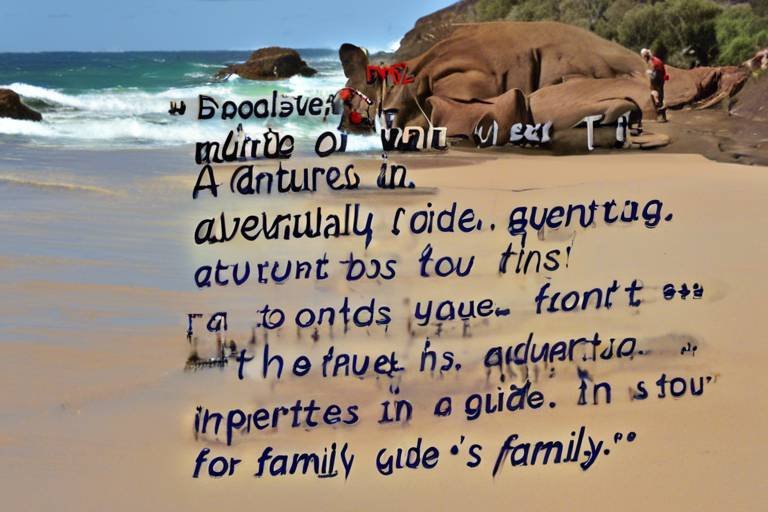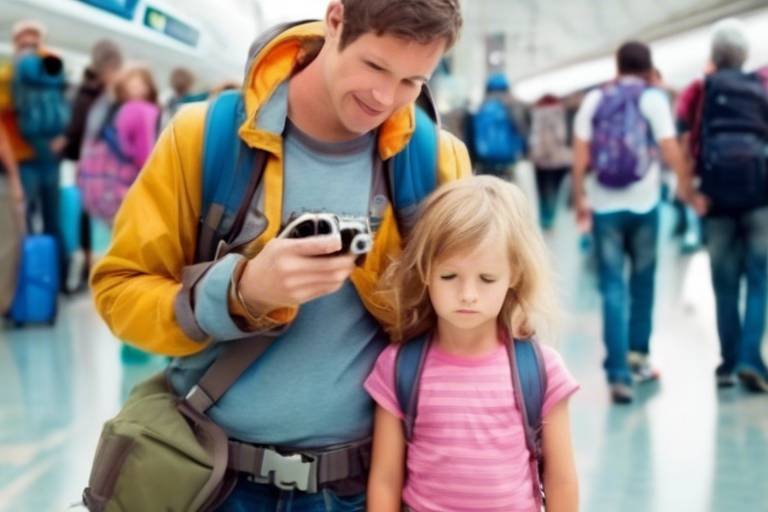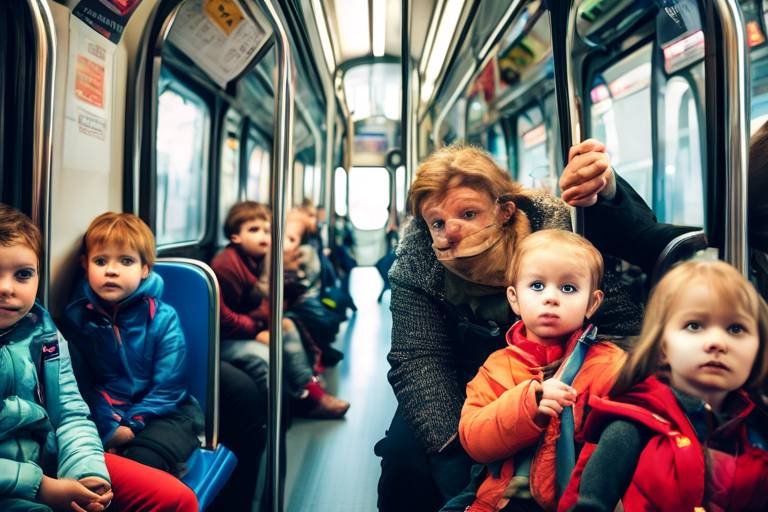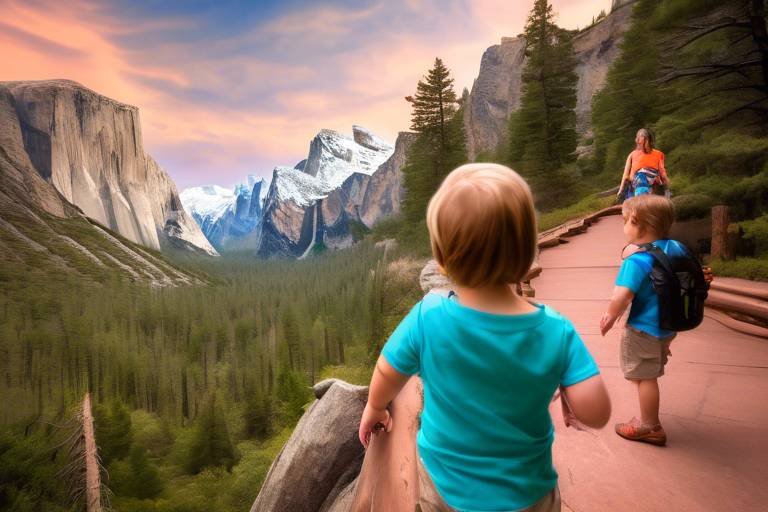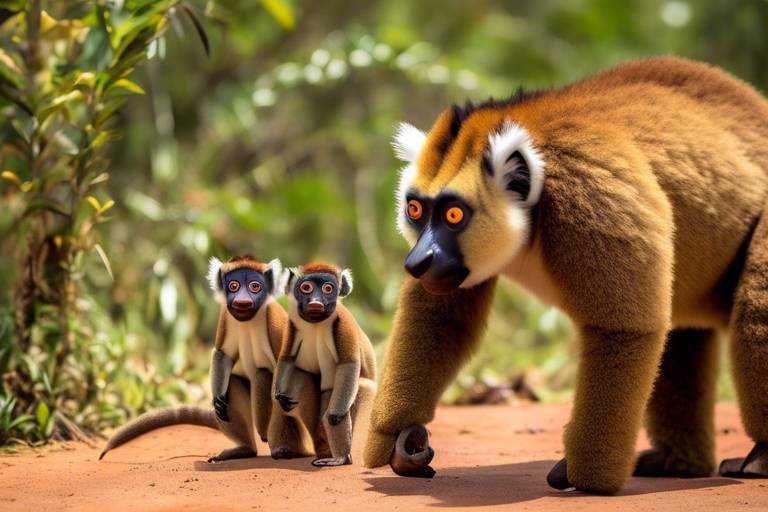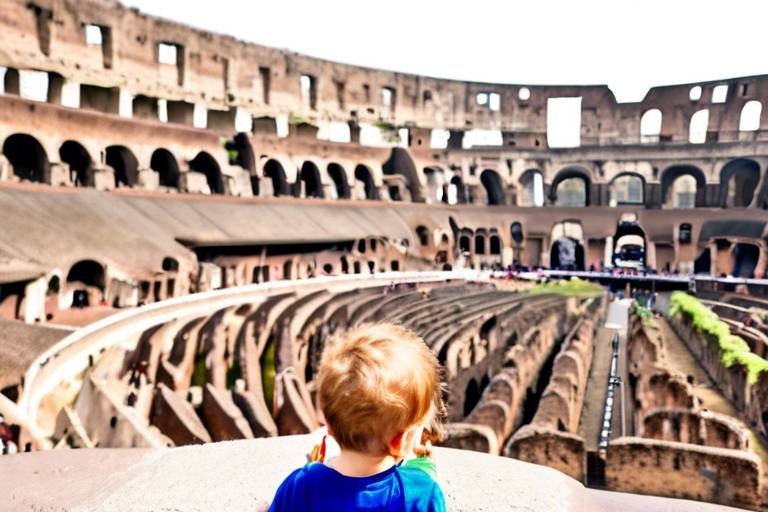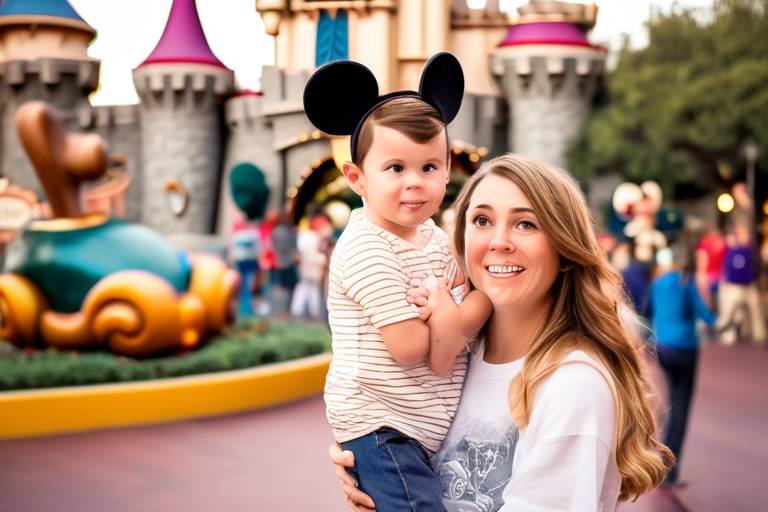Teaching Kids about Nature: Family Trip to Papua New Guinea
Imagine stepping into a world where vibrant colors dance in the air, and the sounds of nature sing a symphony that captivates the soul. Teaching kids about nature through a family trip to Papua New Guinea is not just an adventure; it's an opportunity to ignite a passion for the environment that can last a lifetime. This remote paradise, nestled in the heart of the Pacific, boasts some of the most astonishing biodiversity on the planet, making it a perfect classroom for young explorers. From the lush rainforests that blanket the land to the stunning coral reefs teeming with life, Papua New Guinea offers an immersive experience that can transform how children perceive the natural world.
During your trip, every moment spent in this enchanting landscape can serve as a lesson in ecology, conservation, and respect for nature. Picture your children hiking through dense forests, marveling at the towering trees that have stood for centuries, or snorkeling in crystal-clear waters, discovering colorful fish darting among vibrant corals. These experiences not only foster a sense of wonder but also instill a deep understanding of the delicate balance that sustains our planet.
Moreover, engaging with local cultures adds another layer of richness to this educational journey. Children can learn about the indigenous peoples of Papua New Guinea, their traditions, and how they coexist with the land. This connection between culture and nature is vital, as it teaches kids that the environment is not just a backdrop for adventure but a living entity that deserves respect and protection.
As the family embarks on this unforgettable journey, they will encounter countless opportunities to learn and grow. Whether it's through guided tours in national parks, wildlife encounters that leave them in awe, or cultural exchanges that broaden their horizons, every aspect of the trip is designed to inspire a lasting love for nature. So, pack your bags, grab your kids, and prepare for an adventure that promises to be as educational as it is exhilarating!
Next, let's dive deeper into the diverse ecosystems that make Papua New Guinea a unique destination for nature lovers. This country is home to an astonishing variety of habitats, each playing a crucial role in supporting the rich tapestry of life found here. From the dense rainforests that cover the mainland to the intricate coral reefs surrounding its islands, the ecosystems are not only beautiful but also vital for global biodiversity.
In fact, Papua New Guinea is known for having some of the highest levels of biodiversity in the world. The rainforests are filled with unique plant species, many of which are not found anywhere else on Earth. Similarly, the coral reefs are a hotspot for marine life, serving as nurseries for countless species of fish and other creatures. Understanding these ecosystems can help children appreciate the importance of conservation efforts and the role they can play in protecting our planet.
Planning a family trip to Papua New Guinea can be an exciting challenge. Here are some tips to ensure you make the most of your adventure:
- Best Time to Visit: The dry season, from May to October, is ideal for exploring the outdoors.
- Necessary Preparations: Ensure you have the right vaccinations and travel insurance before your trip.
- Travel Itineraries: Focus on nature exploration by including visits to national parks and marine reserves.
When it comes to choosing activities, consider those that are both fun and educational. Hiking through the jungles, snorkeling in the reefs, and visiting local villages are just a few options that will engage children and encourage them to learn about their surroundings.
National parks in Papua New Guinea are treasure troves of unique flora and fauna. Each park offers a different glimpse into the country's natural beauty, providing opportunities for wildlife spotting and learning about conservation efforts firsthand.
Imagine your child's eyes lighting up at the sight of a rare bird or a playful wallaby! Wildlife encounters in Papua New Guinea offer unforgettable moments that can spark a lifelong interest in nature.
Engaging with the local cultures during your trip is essential. It helps children understand the deep connection between indigenous peoples and their environment, fostering a sense of respect and appreciation for different ways of life.
Before and during your trip, consider utilizing various educational resources. Books, documentaries, and interactive apps can enhance your children's understanding of the ecosystems and cultures they will encounter.
Encourage your kids to keep a nature journal during the trip. This activity allows them to observe, record, and reflect on their experiences, making their learning experience more personal and memorable.
After returning home, continue nurturing their love for nature. Engage in community projects, start a garden, or simply explore local parks together. These activities will help reinforce the lessons learned during your trip and inspire a lifelong appreciation for the environment.
Q: What is the best time to visit Papua New Guinea for nature activities?
A: The dry season from May to October is ideal for outdoor activities.
Q: Are there family-friendly accommodations in Papua New Guinea?
A: Yes, many lodges and resorts cater to families and offer various activities.
Q: How can we engage with local cultures during our visit?
A: Participate in guided tours, local festivals, and community projects to learn about their traditions.

Understanding Papua New Guinea's Ecosystem
Papua New Guinea (PNG) is a treasure trove of biodiversity, a place where nature thrives in its most vibrant forms. Imagine stepping into a living canvas painted with the colors of lush rainforests, the azure of coral reefs, and the rugged beauty of mountainous terrains. This island nation is home to some of the most diverse ecosystems on the planet, making it a perfect destination for families eager to teach their kids about the wonders of nature.
The rainforests of Papua New Guinea are often regarded as the lungs of the Earth. They are filled with towering trees, exotic flowers, and a cacophony of sounds from various wildlife. These forests are not just beautiful; they are vital for maintaining global biodiversity. Did you know that PNG is home to over 5% of the world’s known species? This includes unique animals like the tree kangaroo and the cassowary, which can only be found in this region.
Moving from the dense forests to the vibrant coral reefs, the ecosystem shifts dramatically. The waters surrounding Papua New Guinea are teeming with life, from colorful fish darting between the corals to the majestic sea turtles gliding gracefully. Snorkeling here is like entering an underwater world where children can learn about marine ecosystems and the importance of coral reefs in maintaining ocean health. These reefs not only provide habitat for countless marine species but also protect coastlines from erosion.
Finally, let’s not forget the mountainous regions, which offer a different yet equally fascinating ecosystem. The highlands are home to unique flora and fauna, including rare orchids and birds of paradise, which are a sight to behold. Hiking through these mountains provides an excellent opportunity for families to bond while learning about the geological and ecological significance of these high-altitude environments. Each step taken on these trails is a lesson in conservation and respect for nature.
In understanding these ecosystems, it becomes clear that they are interconnected. The health of the rainforests affects the coral reefs, and the mountains play a crucial role in the water cycle that nourishes both. This interconnectedness is a vital lesson for children, teaching them that every action has a reaction in the natural world. By fostering an appreciation for these ecosystems, we can inspire the next generation to become stewards of the environment.
In summary, Papua New Guinea’s ecosystems are a magnificent classroom for families. They offer an immersive experience where children can learn about biodiversity, conservation, and the delicate balance of nature. Whether it's through hiking in the mountains, snorkeling in the reefs, or exploring the rainforests, the lessons learned here will resonate long after the trip is over.
- What is the best time to visit Papua New Guinea for nature exploration?
The dry season from May to October is ideal for outdoor activities. - Are there guided tours available for families?
Yes, many guided tours cater specifically to families, ensuring a safe and educational experience. - What should we pack for a trip focused on nature exploration?
Essentials include comfortable hiking shoes, snorkeling gear, insect repellent, and a nature journal for observations.

Planning the Perfect Family Trip
When it comes to planning a family trip to Papua New Guinea, the excitement can be as vast as the ocean surrounding its stunning islands. But before you pack your bags and head off to this tropical paradise, there are a few things you need to consider to ensure your adventure is as smooth as a calm sea. First and foremost, think about the best time to visit. Papua New Guinea has a tropical climate, which means it's generally warm and humid year-round. However, the dry season, which runs from May to October, is often considered the ideal time for families to explore the great outdoors without the worry of torrential rains interrupting your plans.
Next, let's talk about preparations. You'll want to ensure that your family is well-equipped for this remarkable journey. Start by checking your passports and obtaining any necessary visas. Health precautions are also crucial; consult your doctor about vaccinations and consider bringing a first aid kit tailored for tropical environments. Packing light, breathable clothing, sturdy shoes for hiking, and swim gear for snorkeling is essential. Don’t forget to include insect repellent and sunscreen, as these will be your best friends under the Papua New Guinea sun!
Creating a travel itinerary that focuses on nature exploration is key to maximizing your experience. You might want to include visits to some of the country's breathtaking national parks, renowned for their biodiversity and stunning landscapes. For instance, the Goroka National Park is perfect for hiking and bird watching, while the Rabaul Volcano National Park offers a unique glimpse into volcanic activity and its surrounding ecosystems. Make sure to allocate time for cultural experiences as well, as interacting with local communities will enrich your understanding of the environment and its conservation.
While planning your itinerary, consider the ages and interests of your children. You might want to include activities like hiking through lush rainforests, where kids can marvel at towering trees and colorful wildlife, or snorkeling in crystal-clear waters among vibrant coral reefs. These experiences not only provide fun but also foster a deep appreciation for nature. If you are unsure about how to structure your trip, here’s a simple table to help you outline your travel plans:
| Day | Activity | Location |
|---|---|---|
| 1 | Arrival and settle in | Port Moresby |
| 2 | Visit local markets and cultural sites | Port Moresby |
| 3 | Hiking and wildlife spotting | Goroka National Park |
| 4 | Snorkeling adventure | Rabaul |
| 5 | Engage with local tribes | Highlands Region |
| 6 | Relax and enjoy the beach | Kavieng |
| 7 | Departure | Port Moresby |
Finally, remember that flexibility is key. While it’s great to have a plan, be open to spontaneous adventures that may come your way. Whether it’s a chance encounter with a friendly local or a hidden waterfall that beckons you off the beaten path, these unplanned moments often turn into the most cherished memories. With thoughtful planning and a spirit of adventure, your family trip to Papua New Guinea can be a transformative experience that nurtures a love for nature in your children.
Q: What vaccinations do we need before traveling to Papua New Guinea?
A: It's best to consult with your healthcare provider, but common vaccinations include Hepatitis A, Typhoid, and Tetanus. Malaria prophylaxis may also be recommended.
Q: Is it safe for families to travel in Papua New Guinea?
A: While Papua New Guinea has areas that are safe for tourists, it's essential to stay informed about local conditions and follow travel advisories. Always travel in groups and avoid remote areas after dark.
Q: What is the currency used in Papua New Guinea?
A: The currency is the Papua New Guinean Kina (PGK). It's advisable to have some local currency, as not all places accept credit cards.
Q: Are there any family-friendly accommodations available?
A: Yes, there are various family-friendly hotels and lodges throughout Papua New Guinea, many of which offer amenities tailored for children.

Choosing Family-Friendly Activities
When it comes to planning a family trip to Papua New Guinea, one of the most exciting aspects is selecting family-friendly activities that not only entertain but also educate. Imagine your kids' eyes lighting up as they spot a vibrant bird of paradise or swim alongside colorful fish in crystal-clear waters! Papua New Guinea offers a plethora of activities that allow families to connect with nature and each other, making unforgettable memories along the way.
One fantastic way to immerse your family in the natural beauty of Papua New Guinea is through hiking. With trails that wind through lush rainforests and up to breathtaking mountain vistas, hiking is an adventure that can be tailored to fit all ages and skill levels. For younger children, consider shorter, guided walks that focus on the unique flora and fauna of the region. These guided hikes often include knowledgeable local guides who share fascinating stories and facts about the environment, turning each step into a learning experience.
Snorkeling is another must-do activity for families visiting the stunning coral reefs surrounding Papua New Guinea. The underwater world is like a vibrant painting come to life, filled with an array of fish species and coral formations that will leave your family in awe. Many tour operators offer family-friendly snorkeling excursions, complete with equipment rental and safety instructions. This hands-on experience not only helps children develop a love for marine life but also teaches them about the importance of preserving these delicate ecosystems.
Wildlife watching is an adventure that can spark curiosity and wonder in children of all ages. Papua New Guinea is home to some of the world’s most extraordinary creatures, including the elusive cassowary and the colorful bird of paradise. Consider planning a visit to a wildlife sanctuary or participating in a guided tour that focuses on spotting these unique animals in their natural habitats. The thrill of encountering wildlife up close can be both exhilarating and educational, providing children with a deeper understanding of biodiversity.
For families looking to engage in cultural activities, consider visiting local villages where you can participate in traditional crafts or cooking classes. These experiences not only provide a fun, hands-on activity but also give your children valuable insights into the rich cultural tapestry of Papua New Guinea. Learning about the indigenous peoples’ relationship with nature enhances children's appreciation for the environment and encourages them to think critically about sustainability.
In summary, choosing family-friendly activities in Papua New Guinea can be a delightful blend of adventure, education, and cultural immersion. With options like hiking, snorkeling, wildlife watching, and engaging with local traditions, your family is sure to create lasting memories while fostering a deeper connection to the natural world.
1. What is the best time to visit Papua New Guinea for family activities?
The best time to visit is during the dry season, which typically runs from May to October. This period offers pleasant weather and clearer conditions for outdoor activities.
2. Are there any safety concerns for families traveling to Papua New Guinea?
While Papua New Guinea is generally safe for tourists, it's important to stay informed about local conditions and follow travel advisories. Always opt for guided tours, especially in remote areas.
3. How can we prepare our children for a trip to Papua New Guinea?
Engage your children in discussions about the culture, wildlife, and environment of Papua New Guinea before the trip. Reading books or watching documentaries can spark their interest and excitement.
4. What should we pack for family-friendly activities?
Pack lightweight clothing, sturdy hiking shoes, snorkeling gear, sunscreen, insect repellent, and a nature journal for documenting your adventures!

Exploring National Parks
When it comes to immersing your family in the wonders of nature, national parks in Papua New Guinea are absolute treasure troves waiting to be explored. These parks are not just patches of land; they are vibrant ecosystems teeming with life, where every corner can surprise you with a new discovery. Imagine walking through lush rainforests, where the air is thick with the scent of damp earth and the calls of exotic birds. In these parks, your children can learn about the delicate balance of nature and the importance of conserving these precious habitats.
One of the most notable parks is Goroka National Park, known for its stunning landscapes and rich biodiversity. Here, families can engage in activities such as guided hikes that reveal the secrets of the forest. As you traverse the winding trails, you might spot colorful birds of paradise or hear the rustle of a tree kangaroo hidden among the branches. These experiences can spark a child's curiosity and foster a deep appreciation for wildlife.
Another gem is the Varirata National Park, located just outside Port Moresby. This park is perfect for families because it offers a variety of trails suitable for all ages. While hiking, you can teach your kids about the local flora and fauna, explaining how each species plays a role in the ecosystem. The park is also home to several lookout points where you can take in breathtaking views of the surrounding landscape, making it an ideal spot for family photos that capture your adventure.
Visiting these national parks can also provide a fantastic opportunity to discuss conservation efforts. Many parks have programs aimed at protecting endangered species and restoring habitats. By participating in ranger-led activities, your children can learn how they can contribute to these efforts, making the experience not just educational but also empowering. Imagine your child’s face lighting up as they realize they can make a difference in the world!
For families planning a trip, it’s essential to prepare adequately. Here are a few tips:
- Pack Essentials: Bring along sufficient water, snacks, and sunscreen. A first-aid kit is also a must!
- Respect Nature: Teach your kids to stay on marked trails and leave no trace behind.
- Engage with Guides: Don’t hesitate to ask park rangers questions; they are a wealth of information and can enhance your experience.
In conclusion, exploring the national parks of Papua New Guinea is not just about witnessing stunning landscapes; it’s about creating unforgettable memories and learning valuable lessons about our planet. Encourage your children to be curious, ask questions, and appreciate the beauty around them. This journey through nature will not only strengthen your family bonds but also instill a lifelong passion for the environment.

Wildlife Encounters
One of the most thrilling aspects of a family trip to Papua New Guinea is the opportunity for that are not only breathtaking but also educational. Imagine standing in the middle of a vibrant rainforest, surrounded by the sounds of exotic birds and the rustling of leaves, as you spot a tree kangaroo hopping gracefully from branch to branch. This is not just a trip; it’s an adventure that immerses you and your children in the wonders of nature.
Papua New Guinea is home to an astonishing array of wildlife, with over 700 species of birds, countless reptiles, and unique mammals, many of which can only be found in this part of the world. For families, this is a golden opportunity to teach kids about biodiversity and the importance of conservation. How often do you get to see a Bird of Paradise in its natural habitat? These birds are not only stunning with their vibrant colors and elaborate courtship displays, but they also play a crucial role in their ecosystem.
When planning your wildlife encounters, consider visiting places like the Varirata National Park or the Sepik River. These locations offer guided tours that are both safe and informative, allowing your family to learn about the local fauna while respecting their habitats. You might spot a variety of animals, including:
- Cassowaries - These large, flightless birds are often called "living dinosaurs" due to their prehistoric appearance.
- Saltwater Crocodiles - Witnessing these magnificent reptiles in their natural habitat can be both thrilling and educational.
- Orchid species - Papua New Guinea boasts a stunning variety of orchids, many of which are endemic to the region.
Moreover, engaging in wildlife watching is not just about observing; it’s about understanding the delicate balance of ecosystems. Kids can learn how each creature contributes to the environment, from pollinators like butterflies to apex predators that maintain the food chain. Encourage your children to ask questions: What do these animals eat? How do they adapt to their surroundings? This kind of inquiry fosters a sense of curiosity and respect for nature.
For a more interactive experience, consider participating in conservation programs or wildlife rehabilitation centers. These programs often welcome families and provide hands-on learning opportunities about animal care and conservation efforts. It’s a fantastic way for children to see the impact of human actions on wildlife and understand the importance of protecting these magnificent creatures.
In summary, wildlife encounters in Papua New Guinea can be an unforgettable part of your family trip. With so many unique species to observe and learn about, your children will not only have fun but also gain a deeper appreciation for the natural world. So, pack your binoculars and get ready for an adventure that will ignite a lifelong passion for wildlife and conservation!
Q: What is the best time to visit Papua New Guinea for wildlife watching?
A: The dry season, from May to October, is generally the best time for wildlife watching, as animals are more active and easier to spot.
Q: Are there any safety concerns when encountering wildlife?
A: While most wildlife encounters are safe, it’s essential to follow guidelines provided by your guides, maintain a safe distance, and never feed wild animals.
Q: Can children participate in conservation programs?
A: Many conservation programs are family-friendly and encourage children to participate in age-appropriate activities that educate them about wildlife and conservation.

Engaging with Local Cultures
When you embark on a family trip to Papua New Guinea, one of the most enriching experiences is engaging with the local cultures. This vibrant country is home to over 800 indigenous languages and a myriad of unique tribal communities, each with their own customs, traditions, and stories. Imagine walking through a village where the air is filled with the sounds of laughter, music, and the aroma of traditional cooking. It's an opportunity for your children to witness firsthand how different cultures interact with their environment, fostering a deep respect and understanding for the world around them.
Engaging with local cultures is not just about observing; it's about participation. Many communities welcome visitors to join in their daily activities, whether it’s fishing, farming, or crafting. This hands-on involvement can spark curiosity in children, helping them to appreciate the skills and knowledge that have been passed down through generations. For instance, learning to weave baskets or create traditional art can provide a tangible connection to the culture and its relationship with nature.
Moreover, storytelling plays a crucial role in the cultural fabric of Papua New Guinea. Gatherings often include elders sharing tales that embody the wisdom of their ancestors, often intertwined with lessons about the environment. These stories can be captivating for children, making the learning process feel like an adventure. By listening to these narratives, kids can grasp the importance of preserving nature, as many stories highlight the delicate balance between humans and the natural world.
To enhance your family's cultural experience, consider the following activities:
- Participate in Local Festivals: Many villages host vibrant festivals showcasing traditional dances, music, and crafts. These events are a feast for the senses and a perfect way to immerse your family in the local culture.
- Visit Craft Markets: Explore local markets where artisans sell handmade goods. This not only supports the economy but also gives children an appreciation for local craftsmanship.
- Engage in Community Projects: Some organizations offer opportunities to participate in community service, allowing families to contribute positively while learning about local challenges and solutions.
By engaging with local cultures, your family will cultivate a profound appreciation for diversity and the interconnectedness of life. It's about building bridges between different ways of living and understanding that every culture has its unique relationship with nature. This awareness is something that can stay with your children for a lifetime, inspiring them to be more environmentally conscious and culturally sensitive as they grow.
In conclusion, a trip to Papua New Guinea is not just about exploring its stunning landscapes and wildlife; it’s also about connecting with its people and their stories. This engagement enriches your family's travel experience, turning it into an educational journey that fosters empathy, respect, and a deeper understanding of the world’s cultural tapestry.

Educational Resources for Kids
When it comes to teaching kids about nature, especially during a memorable trip to Papua New Guinea, having the right educational resources can make all the difference. Imagine your child, wide-eyed and curious, discovering the vibrant ecosystems that this beautiful country has to offer. To enrich their learning experience, there are numerous books, documentaries, and interactive apps available that cater specifically to young explorers. These resources not only provide valuable information but also spark a sense of wonder and curiosity about the natural world.
For instance, consider incorporating engaging books that delve into the rich biodiversity of Papua New Guinea. Titles like "The Birds of Paradise: Revealing the World's Most Extraordinary Birds" can captivate children's imaginations and teach them about the unique avian species they might encounter. Additionally, documentaries such as "Wild Papua New Guinea" can bring the stunning landscapes and wildlife to life right in your living room, creating a perfect pre-trip excitement that sets the tone for your adventure.
Moreover, technology can play a significant role in education. There are several interactive apps designed for kids that focus on nature and wildlife. Apps like "Seek by iNaturalist" encourage children to identify plants and animals in real-time, making their exploration more interactive and educational. By using these tools, kids can document their findings, learn about various species, and even share their observations with a community of young naturalists around the world.
To further enhance your family's learning experience, you might also consider creating a nature journal during your trip. This journal can serve as a personal record of your adventures, where kids can sketch, write, and reflect on their experiences in nature. By documenting their thoughts and observations, children not only improve their writing skills but also develop a deeper connection to the environment. You can provide prompts such as:
- What was your favorite animal you saw today, and why?
- Describe the sounds you heard in the rainforest.
- What did you learn about the local culture and its connection to nature?
In addition to these resources, parents can also look for educational kits related to wildlife and conservation that can be used both during the trip and at home. These kits often include hands-on activities that make learning about nature fun and engaging. For example, a “Nature Explorer Kit” might come with binoculars, a magnifying glass, and a guidebook, allowing kids to observe and learn about their surroundings in a more immersive way.
Lastly, don't forget to check out local educational centers or visitor centers in Papua New Guinea. Many of these places offer workshops, guided tours, or interactive exhibits that are tailored for children. Engaging with local experts can provide invaluable insights and foster a greater appreciation for the natural world.
In summary, preparing your children for a trip to Papua New Guinea with the right educational resources can turn their adventure into a transformative learning experience. By combining books, documentaries, apps, and hands-on activities, you can inspire a lifelong love for nature in your kids. So gear up, pack those educational tools, and get ready to embark on an unforgettable journey that will resonate with your family for years to come!
Q: What are some recommended books for kids about Papua New Guinea?
A: Some great titles include "The Birds of Paradise: Revealing the World's Most Extraordinary Birds" and "Papua New Guinea: A Natural History." These books provide insights into the unique wildlife and ecosystems of the region.
Q: Are there any educational apps for kids that focus on nature?
A: Yes! "Seek by iNaturalist" is a fantastic app that encourages kids to explore and identify various plants and animals they encounter during their trip.
Q: How can we create a nature journal for our trip?
A: A nature journal can be as simple as a notebook where kids can sketch, write observations, and reflect on their experiences. You can provide prompts to guide their entries and encourage creativity.
Q: What local educational resources should we look for in Papua New Guinea?
A: Look for visitor centers, local workshops, and guided tours that focus on wildlife and conservation. These experiences can greatly enhance your children's understanding of the environment and its significance.

Nature Journaling Activities
Nature journaling is an incredible way to help kids connect with the environment during your family trip to Papua New Guinea. Imagine your little ones sitting under a vibrant green canopy, sketching the intricate patterns of leaves or jotting down observations about the unique wildlife they encounter. This activity not only fosters creativity but also encourages mindfulness and a deeper appreciation for the natural world. So, how do you get started with nature journaling? Here are some engaging activities to consider:
First, equip your children with a sturdy notebook and some colored pencils or watercolors. The act of drawing what they see can significantly enhance their observational skills. Encourage them to document their experiences by sketching animals, plants, or landscapes. For example, if you spot a colorful bird, have them draw it and write a few notes about its behavior and habitat. This not only makes the experience memorable but also reinforces learning through art.
Another exciting activity is to create a nature scavenger hunt. Before heading out, compile a list of items commonly found in Papua New Guinea's diverse ecosystems. These can include:
- Different types of leaves
- Unique flowers
- Animal tracks
- Shells from the beach
As your kids search for these items, they can sketch or write about each find in their journal. This interactive approach not only makes learning fun but also encourages them to pay attention to their surroundings.
Consider incorporating sensory experiences into the journaling process. Ask your children to close their eyes and listen to the sounds of the rainforest or feel the textures of various plants. They can then write or draw about what they experienced, capturing the essence of the environment in their own unique way. This method cultivates a sense of presence and enhances their connection to nature.
After your trip, you can take journaling a step further by having your kids create a nature book at home. They can compile their sketches, notes, and even photographs taken during the trip into a personalized book. This not only serves as a wonderful keepsake but also provides an opportunity for them to share their experiences with family and friends, fostering a sense of pride in their newfound knowledge.
Incorporating these nature journaling activities into your family trip to Papua New Guinea can transform ordinary moments into extraordinary learning experiences. By encouraging your children to observe, record, and reflect, you’re not just teaching them about nature; you’re instilling a lifelong love and respect for the environment.
Q: What materials do we need for nature journaling?
A: All you need is a notebook or sketchbook, colored pencils or watercolors, and a sense of adventure! You can also bring a camera for capturing moments.
Q: How can I encourage my child to write more in their journal?
A: You can prompt them with questions like, "What did you notice about that bird?" or "How did the leaves feel?" This can inspire them to express their thoughts and observations.
Q: Can nature journaling be done at home?
A: Absolutely! Encourage your kids to observe their backyard or local parks. They can record changes in seasons, different animals, or plants they come across.

Post-Trip Learning Opportunities
Returning home after an exhilarating trip to Papua New Guinea doesn't mean the adventure has to end. In fact, this is the perfect time to capitalize on the experiences your family has had, ensuring that the lessons learned about nature and conservation continue to resonate. One of the most effective ways to do this is through engaging projects that allow your children to reflect on their trip and apply what they've learned in a meaningful way.
For instance, you could set up a family project where each member chooses a specific animal or plant they encountered during the trip. This could lead to a fun and educational experience where everyone researches their chosen subject, creating presentations or posters. Not only does this encourage individual learning, but it also fosters discussions about the ecosystems in Papua New Guinea and the importance of biodiversity.
Another fantastic opportunity is to involve your children in community conservation efforts. Many local organizations focus on preserving wildlife and natural habitats, and they often welcome volunteers. By participating in these efforts, your kids will gain firsthand experience in conservation work, understanding the importance of protecting the environment while also making a positive impact in their community.
To further enhance their learning experience, consider introducing them to various educational resources that complement what they experienced in Papua New Guinea. Here are a few suggestions:
- Books: Look for children's books about the unique wildlife and ecosystems of Papua New Guinea. Stories that incorporate local myths and legends can also deepen their understanding of the culture.
- Documentaries: Watching documentaries about the region can provide visual context to their experiences, reinforcing the importance of conservation and biodiversity.
- Interactive Apps: There are numerous apps designed for kids that focus on wildlife identification and conservation. These can be a fun way to keep their interest alive while learning.
Lastly, consider starting a nature journal at home, where your children can continue to document their observations of the natural world around them. Encourage them to draw, write, or even photograph plants and animals they encounter in their own backyard or local parks. This practice can help cultivate a lifelong appreciation for nature and inspire them to become stewards of the environment.
In conclusion, the learning opportunities post-trip are vast and varied. By engaging in projects, volunteering, utilizing educational resources, and maintaining a nature journal, your family can keep the spirit of your Papua New Guinea adventure alive. This not only reinforces the knowledge gained during your travels but also instills a deep-rooted love for the environment in your children, making them more aware and responsible global citizens.
Q: How can I keep my kids interested in nature after our trip?
A: Engage them in projects, volunteer for conservation efforts, and encourage nature journaling to maintain their interest.
Q: What are some good resources for learning about Papua New Guinea's wildlife?
A: Look for books, documentaries, and interactive apps that focus on the region's unique ecosystems and species.
Q: How can we get involved in local conservation efforts?
A: Research local organizations that focus on wildlife preservation and volunteer for their programs or events.
Frequently Asked Questions
- What is the best time to visit Papua New Guinea for a family trip?
The best time to visit Papua New Guinea is during the dry season, which typically runs from May to October. During these months, the weather is more pleasant, and outdoor activities like hiking and snorkeling are more enjoyable. Plus, you’ll have a better chance of spotting wildlife!
- Are there family-friendly activities available in Papua New Guinea?
Absolutely! Papua New Guinea offers a plethora of family-friendly activities. You can go hiking through lush rainforests, snorkeling in vibrant coral reefs, or even participate in cultural festivals. Each activity not only entertains but also educates your kids about nature and local traditions.
- How can we engage with local cultures during our trip?
Engaging with local cultures is key to making your trip memorable. You can visit indigenous villages, participate in traditional ceremonies, or take part in local crafts. This interaction helps children understand the deep connection between the indigenous peoples and their natural surroundings, fostering respect and appreciation for different cultures.
- What wildlife can we expect to see in Papua New Guinea?
Papua New Guinea is home to some incredible wildlife! Families can expect to see unique species like the bird of paradise, tree kangaroos, and various colorful reptiles. Guided tours often provide insights into their habitats and behaviors, making it an educational experience for the whole family.
- Are there educational resources available for kids before and during the trip?
Yes! There are many educational resources to enhance your children’s learning experience. Consider bringing along books about Papua New Guinea’s wildlife, documentaries about its ecosystems, or interactive apps that focus on nature. These resources can spark curiosity and prepare them for what they’ll see and learn.
- What is nature journaling, and how can we do it on our trip?
Nature journaling is a fantastic way for kids to observe and reflect on their experiences in nature. During your trip, encourage your children to draw pictures, write descriptions of the animals and plants they see, or even jot down their feelings about the landscapes. It’s a fun and creative way to document their adventures!
- How can we continue learning about nature after our trip?
Continuing the education about nature after your trip can be as simple as engaging in projects related to conservation or volunteering in local environmental initiatives. You can also create a scrapbook of your trip, share stories with friends, or even start a family garden to inspire a lifelong appreciation for the environment.








